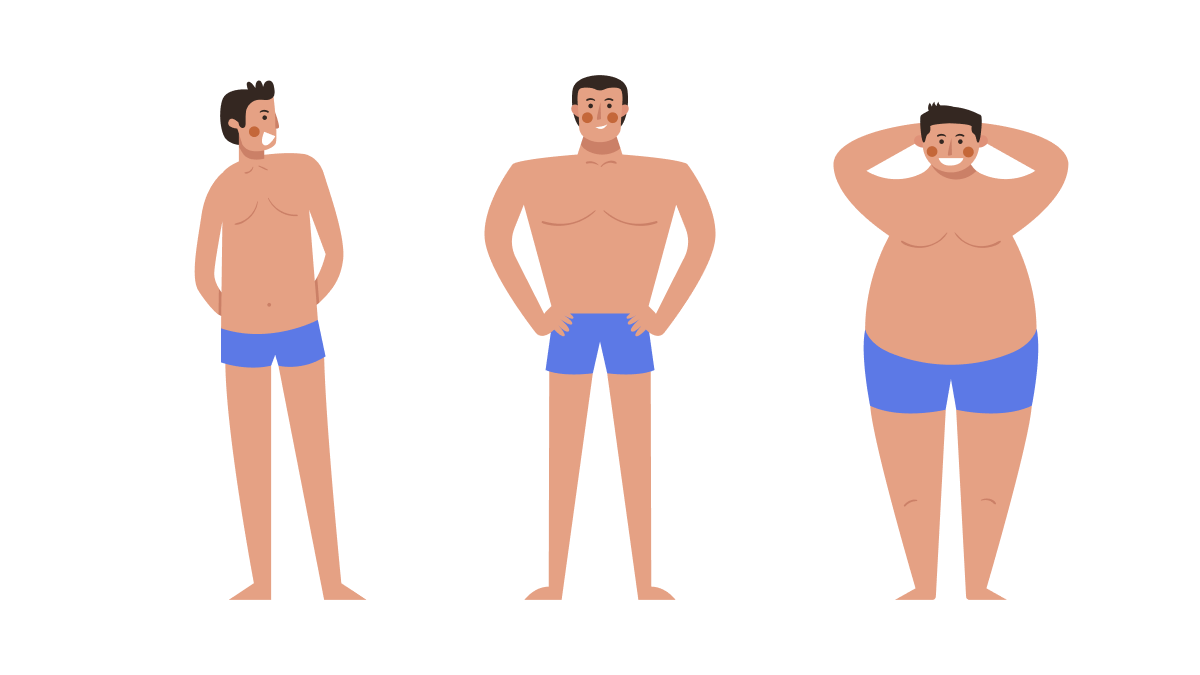
Ectomorph, Mesomorph, and Endomorph.
These terms look and sound like they belong to the scientific, or science fiction worlds.
However, each word refers to a specific kind of body type. The category you fall into is what dictates your response to workouts, certain foods, even dietary choices.
Leaders like Joanna Soh are shaking up the health and fitness world by showing us how our body composition, bone structure, and fat/muscle distribution can change our lives.
In a celebration of all body types, we decided it was time to shed some light on the concept of ectomorph, mesomorph, and endomorph vody types. Today, you’ll learn how to define your body type, what each category means, and how you can adapt your health strategy to suit your unique needs.
Just Your Type: Are You Ectomorph, Mesomorph or Endomorph?

Let’s start with the basics.
Endomorph, mesomorph, and ectomorph are all words that refer to a kind of body type. Your body type is decided by a variety of genetic and environmental factors. The categories we’re discussing today address everything from your fat/muscle ratio, your skeletal structure, and more.
Here’s what you need to know about each type.
Characteristics of an Ectomorph
Defining characteristics of the ectomorph include tall, thin, and lanky limbs. Individuals defined as ectomorphs often have rounder bone structures, with wide hips and stocky limbs. However, these people tend to struggle with gaining weight, regardless of what they eat. If you’re an ectomorph, you’ll have a lean body with small muscles, which means you’ll need a lot of carbs to gain weight.
Experts recommend eating a lot of protein if you’re an ectomorph, to help with building muscles. You might also need to invest in high-intensity interval training to make the biggest difference to your body.
Characteristics of an Endomorph
Almost the exact opposite of an ectomorph, endomorphs find it very difficult to get rid of fat. These individuals gain weight faster and often look curvy. If you’re an endomorph, you’ll have a more triangular bone structure, with narrow hips, broad shoulders, and shorter limbs.
Endomorphs gain more muscle during workouts, but a slow metabolism means they’re more likely to store fat than build muscle. If you’re an endomorph, you’ll need to keep carbs low and improve your intake of good fats and protein. Cardio, high-intensity exercise, and metabolism-boosting routines are common among endomorphs.
Characteristics of a Mesomorph
Considered by many to be the “ideal” body type, a mesomorph individual looks lightweight and well-structured, with a flatter ribcage, thinner bones, long limbs, and a rectangular bone structure. Mesomorphs aren’t underweight or overweight, they have a natural tendency to stay at their perfect level. Hence, mesomorphs can experiment with different foods and diets to maintain their ideal weight.
Mesomorphs often benefit from extra exposure to vegetables and fruits rich in antioxidants and will appreciate a protein-based diet for muscle building. To maintain muscle, mesomorphs should also commit to regular bouts of cardio and weight-based training.
Fitness Tips for Different Somatype Categories

We definitely recommend checking out Joanna Soh’s video for more insights into the somatypes (different body types) and categories you might fall into.
Ectomorph Workout Options
Ectomorphs are naturally skinnier and find it harder to gain muscle and fat. If this applies to you, you’ll need to really follow the fundamentals when it comes to building muscle. This means increasing your calorie intake carefully. Make sure you know the right diet for your genes before you increase your food intake. Protein levels are particularly important for gaining muscle.
Consume protein regularly before and after your workout, and remember to focus on strategies for building muscle. Strength training and high-intensity interval training will be excellent for keeping your body working as much as possible. Hypertrophy strength training is common among ectomorphs, as is consuming protein before bed to boost synthesis rates.
Endomorph Workout Options
As an endomorph, your major concern may be on losing fat. This means you’ll need to cut down your calorie intake carefully. You could consider looking into intermittent fasting to help improve your metabolic rate and cut down on foods with high-calorie counts. Though your exact dietary strategy should depend on your genetic traits, it’s often good to start by reducing fat intake and increasing protein consumption.
Protein is great for converting energy into muscle, which will help you to burn more fat long-term. You may also want to cut down on carbs, depending on how your body metabolises them. For training, focus on cardio first. High-intensity cardio training will help to burn fat and improve your overall endurance levels. You can also try HIIT and circuit training to start boosting your metabolic rate.
Endomorphs are more likely to take on weight, so be careful about the kind of exercise you do if you’re already a little overweight. Weight-bearing exercises will be more likely to create joint issues before you lose weight. Strength training is also essential to give yourself the power you need to continue working out. The more muscle you have, the faster you’ll burn fat too.
Mesomorph Workout Options
Some people assume that because Mesomorphs have the “ideal” body type, they don’t have to work as hard to maintain that structure. However, the reality is that you do need to work if you want to maintain your body. You’ll start to lose muscle mass as you get older as a mesomorph, so it’s important to use strength training and muscle building to counteract this.
If you’re a mesomorph, try to find a sport or activity you can enjoy and commit to for as long as possible. Step up your strength training and make sure you’re eating a balanced diet with plenty of protein, particularly as you begin to age.
Remember that you can also easily gain weight just as much as you can gain muscle as a mesomorph. With this in mind, be cautious about your carb and fat levels.
What if You Fall Between Categories?

Knowing your body type is a great way to turbo-charge your workout and diet strategy.
This is one of the reasons why we always recommend a genetic DNA test for anyone in search of the perfect fitness routine. Knowing how your body works means you can tailor your workouts and meal plans to your specific needs.
Unfortunately, while the categories of endomorph, ectomorph, and mesomorph offer a good starting point, they’re limited in what they can really tell you. Unlike a DNA test which offers a tailored view of your entire genetic structure, these 3 body types can only provide advice based on the category you seem to fall into most.
It’s doubtful that you’re going to be a pure endomorph ectomorph or mesomorph. Most people need to use the Heath-Carter method for measuring what mix of somatypes they are. With this rating system, you’d be scored in endomorph features first, then mesomorph, then ectomorph.
A rating of 1-7-5 would be mostly mesomorph but with a lot of ectomorph tendencies.
The fact that we all fall into multiple somatype groups means it’s a bit tougher to train exactly for “your body type.” For instance, you might be a mesomorph and endomorph mix who gains muscle quickly, but also gains weight fast when you add extra carbs to your diet.
When you’re planning the ideal exercise and diet plan, you’ll need to ensure that you’re looking at all of your somatypes, not just the one category you sway into most.
Transforming your Body, the Right Way

The good news for anyone who hasn’t identified with their “ideal” body type here is that your somatype isn’t a life sentence. While you are more likely to gain weight or maintain muscle with some body types than others, you can still make a difference. To your body weigh the right training, diet, and strategy.
The first step is making sure you understand all of your body, not just a part of it. Get a CircleDNA test to learn more about your genetic structure, and how various factors in your body might be influencing the way you gain and lose weight. Your DNA can give you a behind-the-scenes look at why certain exercise and diet routines aren’t working for you.
Once you understand your body type and your genetics, you can begin to build a workout strategy built for your needs. This could mean swapping carbs and fat for more protein in your diet, investing in intermittent fasting strategies, or changing up your exercise efforts.
Somatypes, like any insight into your body, can provide you with valuable information on how to upgrade your health and fitness routine. However, it’s still up to you to take a closer look at the finer details and tune your strategy accordingly.
Want to learn more? Head over to CircleDNA to learn more about yourself!






